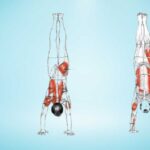Pneumonia, a stealthy adversary affecting the respiratory system, demands our attention. In this exploration, we delve into the symbiotic relationship between pneumonia and diaphragmatic breathing, an all-natural remedy that unveils a path to recovery.
What is Pneumonia and Why? Learn Diaphragmatic Breathing
Pneumonia is a stealthy lung infection causing inflammation in the delicate air sacs. It’s critical to catch symptoms like fever, cough, and breathing issues early. Learning diaphragmatic breathing is also key – let’s explore how this intentional air flow clears infection and optimizes lung health.
Common Pneumonia Symptoms to Watch Out For
Pneumonia announces itself through signature markers playing out like a silent code in the body – fever signifies inflammation, cough points to irritated airways, and breathing struggles reflect distressed lungs. Spotting this symptom trifecta promptly can dictate the course of healing.
How Pneumonia Can Become Dangerous if Left Untreated
Without timely care, pneumonia gains destructive momentum, spreading through the lungs’ branched air channels. A cascade of complications awaits – lung tissue scarring, abscess formation, respiratory failure, and even sepsis. Getting prompt help, whether with medication or breathing training, prevents this descent into dangerously diseased lungs.
Introducing Diaphragmatic Breathing as an All-Natural Treatment
Beyond standard treatments, diaphragmatic breathing has emerged as an accessible, drug-free therapy for pneumonia patients. Also called belly breathing, this practice utilizes the diaphragm muscle below the lungs to power inhalation, generating a deep cleansing air flow with therapeutic effects.
An Overview of the Impressive Benefits of Diaphragmatic Breathing
The perks of regular diaphragmatic breathing range from stimulated immunity and reduced inflammation to improved oxygen circulation, detoxed airways, lower stress levels, and relaxed respiratory muscles. By actively engaging the lungs, it facilitates healing on multiple physiological levels.
How Diaphragmatic Breathing Boosts Lung Health
As we inhale deeply down to the belly, the descending diaphragm creates strong vacuum pressure in the chest, drawing abundant fresh air into the alveolar air sacs. It allows oxygen-rich air to penetrate deeply, ventilating scarred infected pockets while also flushing mucus and bacteria up and out through exhaling.
Step-by-Step Guide to Master Diaphragmatic Breathing
Start by lying down; place one hand on your chest and the other on your belly. Inhale slowly through your nose for a count of four, feeling your abdomen rise. Exhale gently for a count of six until the abdomen falls. Repeat this cycle 10 times, focusing on making the belly hand rise and fall more than the chest hand with each breath. Then try the sequence seated upright, then walking slowly.
Diaphragmatic Breathing Exercise #1: Basic Belly Breathing
This foundational exercise connects breath with fluid abdominal movement, redirecting inhalation effort from the chest to the powerful diaphragm muscle below the lungs. Rhythmic pulses of deep oxygen drive respiratory recovery.
Practice Belly Breathing Laying Down Before Progressing
Initially, practicing reclined counteracts gravity’s pull on strained respiratory muscles. Once recumbent belly breathing is mastered, transition to sitting or standing while maintaining core engagement for maximum inhalation.
Diaphragmatic Breathing Exercise #2: Seated Abdominal Breathing
Upright posture adds moderate difficulty, forcing weakened breathing muscles to actively expand against gravity’s pressure while maintaining abdomen-driven breaths. Sit with shoulders back while inhaling first into the belly, then the chest.
Sit Upright While Breathing into Your Belly
Good posture assists by removing extra demands on respiratory muscles that hinder breath capacity. Keep the spine elongated while isolating the abdomen as the primary organ of inhalation for best-seated results.
Diaphragmatic Breathing Exercise #3: 4-7-8 Breathing Technique
This research-backed technique uses counted inhale-hold-exhale cycles to elicit the relaxant nerve response, slowing heart rate and lowering blood pressure. Rhythm and flow maximize air intake while inducing a meditative state.
Learn This Popular Breathing Rhythm for Relaxation
Breathing by numbers – in for 4, hold for 7, exhale for 8 seconds – activates rest-and-digest nervous system pathways, signaling safety. Regular practice combats chronic inflammation and stress while inducing whole-body tranquility.
Diaphragmatic Breathing Exercise #4: Morning Breathing
Starting each day with energizing lung-enhancing breath sets a vitality-affirming tone. Inhale positivity and oxygen while visualizing healing, exhale toxins – physical and mental. Repeat 5 times before moving on with renewed inspiration.
Wake Up Your Lungs with Energizing Breaths
The breathwork-vitality link is bidirectional; not only does lively breathing boost overall energy levels, but intentional energy also maximizes lung capacity. Inhale actively visualizes inflating balloons, infusing breath with vivacity.
Diaphragmatic Breathing Exercise #5: Walking Breathwork
This advanced flowing technique combines controlled breathing with slow, deliberate movement for an intense respiratory workout. Walk calmly while continuously belly breathing, then add arm raise-and-fall with each inhale-exhale cycle for whole-body engagement.
Power Breathe with Coordination While in Motion
The marriage of steady gates and flowing breaths build synchronized strength like an aerobic dance for the lungs. Motion’s dynamic rhythms maximize breathing muscles’ efforts, elevating oxygen-transport capabilities.
Diaphragmatic Breathing Exercise #6: Visualization Breathing
Mental images dynamically impact physiology; picture lungs as open wide-bottomed vases effortlessly receiving breath as streaming water. Visual input heightens focus on inhaled air circulating freely through clear, healed passages.
Enhance Lungs with Positive Imagery
In creative guided visualization, see each inhale sending droplets of vitality to every alveolus, tiny sacs opening to receive oxygen’s nourishing benefits. Lining pathways are smooth, flexible, and strong as air pulses through.
Tips to Maximize Results with Your Breathwork Routine
Consistency and precision are key; set scheduled times for practice. Breathe gently yet deeply – force creates tension, whereas flow relaxes. Maintain an upright posture and add complementary lifestyle changes to sustain improvements.
9 Effective Tips For Yoga Handstand
Remember to Breathe Slowly, Gently and Use Proper Posture
Creating a routine allows progressive refinements, so allot regular short sessions. Smooth, gentle breaths without strain send air thoroughly through more lung fields. Good posture and relaxation ensure open pathways.
Customizing Your Routine Based on Pneumonia Symptom Severity
Be flexible and responsive to the body’s needs by adjusting breathwork duration, difficulty, and posture accordingly. More severe symptoms call for shorter, supported reclined sessions versus easier, extended vigorous flows when recovering.
Listen to Your Body and Adjust Practice as Needed
Tune in non-judgmentally; feeling tired or strained is feedback to breathe shallower and slow down. Pain cues stop and rest. Track observable improvements – evaluate energy, respiration rate, and ease over time as barometers to shape your routine responses.
Troubleshooting Common Problems with Diaphragmatic Breathing
Difficulty breathing deeply, dizziness, or worsened cough may stem from underlying health issues or improper form. Try more supportive postures, focus on long, smooth exhalations, and check in with your doctor to rule out complications.
Struggling to Breathe Deeply? Why…
Shallow breathing often signals constrained lung capacity from pneumonia damage, yet also results from chest tension or posture misalignment, throwing off diaphragm movement. Isolate the root cause, then adjust appropriately.
The Power of Pairing Medication and Breathing Exercises
Pharmaceutical and home remedies can work synergistically to relieve pneumonia on multiple fronts. Antibiotics tackle bacterial infection; mucolytics thin mucus for easier coughing, while breathing training reconstructs damaged gas exchange strength and efficiency.
Use Both Western and Eastern Treatments
Integrative pneumonia treatment strategies recognize the value of both scientifically designed medicines as well as time-tested holistic healing modalities like yoga and diaphragmatic breathwork for cooperative symptom relief.
When to Seek Medical Care for Persistent Pneumonia
Despite vigilant self-care, worsening pneumonia warrants medical intervention – difficulty breathing at rest, bluish skin, and very rapid heart rate indicate oxygen deprivation requiring prompt emergency assistance. Don’t hesitate to ask doctors about concerning lingering signs.
Monitor Symptoms and Ask Your Doctor if Concerned
Vigilance tracking symptom changes is key; record vital signs and oxygenation levels if possible, along with subjective reports of pain and breathing ease. Flag doctor if fever persists beyond 3 days, inhales worsen, or odd symptoms manifest. Insist on explanations.
The Takeaway: Give Diaphragmatic Breathing a Try!
I wholeheartedly encourage beginner’s mind experimentation with this gentle yet profoundly empowering practice – let it unlock your lungs’ dormant resilience and zest for oxygen’s vital energies with each conscious belly breath!
Natural Healing for Your Lungs Is Within You
Remember always – innate self-healing potential abounds in our human forms, waiting to be tapped into via simple rhythmic patterns of breath dancing through respiratory corridors, washing them clean with air’s elixir of life.
















